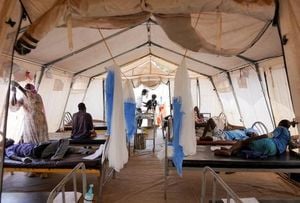Twenty-four years after the September 11 attacks, the United States finds itself at a crossroads—one marked by evolving global threats and a deepening sense of internal crisis. As the world reflects on the legacy of 9/11, the specter of terrorism remains, but so too does a growing anxiety about the nation's moral compass and democratic foundations. Both challenges are shaping America’s role on the world stage and the daily lives of its citizens in ways that would have seemed unimaginable a generation ago.
According to a September 2025 report by The Soufan Center, the global jihadist movement, born out of Osama bin Laden’s vision, has not faded away. Instead, it has transformed, adapting to new realities and exploiting fresh vulnerabilities. Al-Qaeda, once thought to be on the ropes, has found sanctuary again in Afghanistan under the Taliban, who retook the country in August 2021. The United Nations Monitoring Team warned this summer that al-Qaeda’s “appetite for external operations had increased,” even if its operational capacity is somewhat diminished. Affiliates like al-Shabaab in Somalia, al-Qaeda in the Arabian Peninsula (AQAP), al-Qaeda in the Indian Subcontinent (AQIS), and Jam’at Nusrat ul-Islam wal-Muslimin (JNIM) continue to threaten local, regional, and international security.
While al-Qaeda’s core leadership has suffered attrition, with some senior figures—including its de facto head Saif al-Adel—still believed to be based in Iran, the group’s intent to strike the West persists. The lesson, as The Soufan Center notes, is clear: “Taking this organization or any of its regional branches for granted is a recipe for disaster.” This warning echoes the complacency that preceded the devastating October 7, 2023, Hamas attack on Israel, which killed more than 1,200 Israelis and ignited a conflict that shows no sign of abating.
But al-Qaeda is not the only threat. The Islamic State, which once dominated headlines, has also evolved, franchising its operations across continents. Its Afghan affiliate, Islamic State Khorasan Province (ISKP), has demonstrated a relentless intent to conduct external operations, launching successful attacks in Iran, Türkiye, and Russia in 2024. Plots in Europe—including one targeting the Paris Olympics and another a Taylor Swift concert in Vienna—were disrupted, but the danger remains. Large public gatherings, from concerts to sporting events, are likely to stay on terrorists’ radar for their propaganda value and potential for mass casualties.
Sub-Saharan Africa has become a new epicenter of jihadist terrorism. Islamic State West Africa Province (ISWAP) and Islamic State Sahel Province (ISSP) are destabilizing vast regions of the Sahel, clashing at times with al-Qaeda affiliates and undermining governments from littoral West Africa to the Lake Chad Basin. In Central and East Africa, Islamic State Central Africa Province (ISCAP) and affiliates in Somalia and Mozambique are highly active. Russian mercenaries, including the Wagner Group and Africa Corps, have been deployed to “coup-proof” regimes in Niger, Burkina Faso, and Mali, but their scorched-earth tactics often drive local populations toward jihadists, making the problem worse rather than better.
The threat is not confined to distant lands. A New Year’s Day attack in New Orleans in 2024 was a stark reminder of the dangers posed by homegrown violent extremists—individuals radicalized by jihadist propaganda online. Yet, as The Soufan Center points out, the U.S. government’s focus is shifting away from counterterrorism to great power competition, stretched thin by ongoing conflicts in Ukraine, the Middle East, and efforts to combat drug cartels in the Americas. Resources are finite, and counterterrorism agencies are shrinking. In August 2025, Director of National Intelligence Tulsi Gabbard announced a 40% staff reduction at her office, calling the Office of the Director of National Intelligence “bloated and inefficient.”
Emerging technologies are also changing the game. Artificial intelligence, drones, 3-D printing, encryption, and virtual currencies have lowered the barriers for violent non-state actors to acquire advanced tools. Terrorist groups continue to pursue chemical, biological, radiological, nuclear, and high-yield explosives (CBRNE) capabilities, as well as cyber attack tools. These developments make it harder than ever for authorities to stay ahead of the threat.
But the list of threats is broader still. The United States and its allies face growing dangers from Shia extremist groups under Iran’s Axis of Resistance, including Iraqi militias and the Houthis in Yemen. After the U.S. launched Operation Midnight Hammer, targeting Iran’s nuclear infrastructure and supporting Israel’s 12-Day war, concerns have mounted that Tehran could activate Hezbollah sleeper cells within the United States. Iran’s history of playing the long game, maintaining a global network of terrorist cells, keeps security officials on edge.
Meanwhile, the war in Gaza continues to radicalize individuals worldwide, including many in Western societies. And it’s not just jihadist groups that keep authorities up at night. The FBI is now tracking a spectrum of violent extremists: far-left and far-right terrorists, misogynistic “Incels,” technophobes (neo-Luddites), conspiracy theorists, and a new breed of nihilistic violent extremists. These latter actors, as defined by the FBI, are “individuals who engage in criminal conduct within the United States and abroad, in furtherance of political, social, or religious goals that derive primarily from a hatred of society at large and a desire to bring about its collapse by sowing indiscriminate chaos, destruction, and social instability.”
Against this backdrop of external and internal threats, a parallel crisis is unfolding within America’s own borders. In a September 10, 2025, column for Missouri Independent, commentator David Rosman lamented what he called an “identity crisis” and the nation’s slide toward “moral and ethical bankruptcy.” Rosman argued that “many components of our Constitution [are] rendered null and void and two branches of our government—the legislative and judicial—neutered.” He pointed to harsh immigration policies, political gerrymandering in Missouri, and new voting restrictions as evidence of eroding democratic principles. “Our heritage of one person, one vote is no longer available to the many citizens,” Rosman wrote, warning that “the right of the people... to petition the Government for a redress of grievances” is being taken away.
Rosman’s critique is not limited to policy. He sees a deeper shift in the country’s values: “White Christian nationalism has taken a stronghold in our government. Many of Trump’s party are simply afraid of the consequences of their questioning the party line.” The columnist argues that America, once admired for its moral and ethical leadership, is quickly losing its standing, creating a vacuum that adversaries are eager to fill. “It will take years to regain our leadership on the world stage for freedom and civilian rule if at all,” he concludes.
As the U.S. marks the 238th anniversary of its Constitution on September 17, 2025, these dual crises—external threats from an ever-adapting terrorist landscape and internal struggles over democracy and identity—underscore the complexity of the moment. The challenges are daunting, but the stakes could not be higher for the nation’s future, its security, and its soul.




